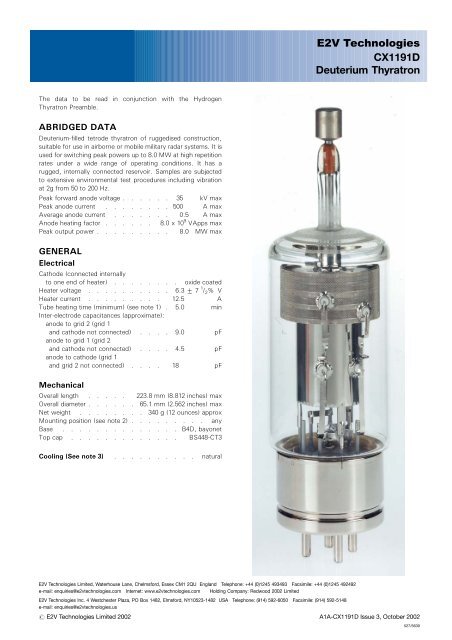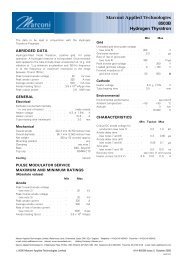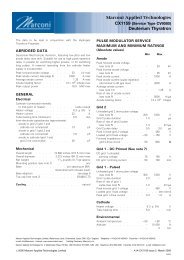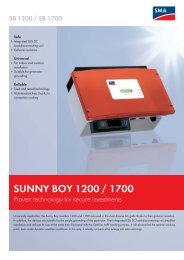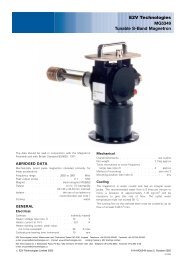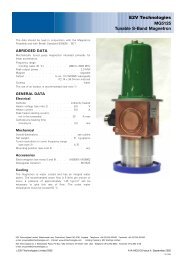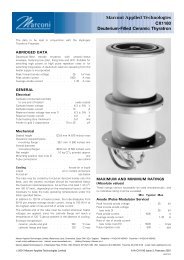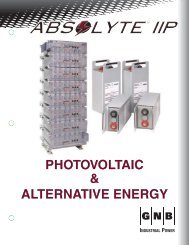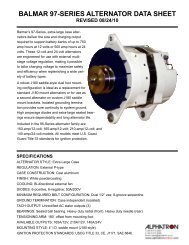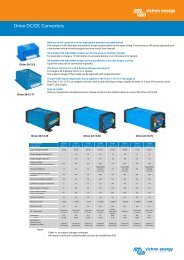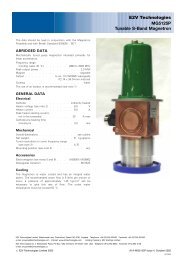E2V Technologies CX1191D Deuterium Thyratron - Alphatron
E2V Technologies CX1191D Deuterium Thyratron - Alphatron
E2V Technologies CX1191D Deuterium Thyratron - Alphatron
You also want an ePaper? Increase the reach of your titles
YUMPU automatically turns print PDFs into web optimized ePapers that Google loves.
<strong>E2V</strong> <strong>Technologies</strong><br />
<strong>CX1191D</strong><br />
<strong>Deuterium</strong> <strong>Thyratron</strong><br />
The data to be read in conjunction with the Hydrogen<br />
<strong>Thyratron</strong> Preamble.<br />
ABRIDGED DATA<br />
<strong>Deuterium</strong>-filled tetrode thyratron of ruggedised construction,<br />
suitable for use in airborne or mobile military radar systems. It is<br />
used for switching peak powers up to 8.0 MW at high repetition<br />
rates under a wide range of operating conditions. It has a<br />
rugged, internally connected reservoir. Samples are subjected<br />
to extensive environmental test procedures including vibration<br />
at 2g from 50 to 200 Hz.<br />
Peak forward anode voltage . . . . . . 35 kV max<br />
Peak anode current . . . . . . . . 500 A max<br />
Average anode current . . . . . . . 0.5 A max<br />
Anode heating factor . . . . . . 8.0 x 10 9 VApps max<br />
Peak output power . . . . . . . . . 8.0 MW max<br />
GENERAL<br />
Electrical<br />
Cathode (connected internally<br />
to one end of heater) . . . . . . . . oxide coated<br />
Heater voltage . . . . . . . . . . 6.3 + 7 1 / 2 %V<br />
Heater current . . . . . . . . . 12.5 A<br />
Tube heating time (minimum) (see note 1) . 5.0 min<br />
Inter-electrode capacitances (approximate):<br />
anode to grid 2 (grid 1<br />
and cathode not connected) . . . . 9.0 pF<br />
anode to grid 1 (grid 2<br />
and cathode not connected) . . . . 4.5 pF<br />
anode to cathode (grid 1<br />
and grid 2 not connected) . . . . 18 pF<br />
Mechanical<br />
Overall length . . . . . 223.8 mm (8.812 inches) max<br />
Overall diameter . . . . . . 65.1 mm (2.562 inches) max<br />
Net weight . . . . . . . . 340 g (12 ounces) approx<br />
Mounting position (see note 2) . . . . . . . . . any<br />
Base . . . . . . . . . . . . . . B4D, bayonet<br />
Top cap . . . . . . . . . . . . . BS448-CT3<br />
Cooling (See note 3) . . . . . . . . . . natural<br />
<strong>E2V</strong> <strong>Technologies</strong> Limited, Waterhouse Lane, Chelmsford, Essex CM1 2QU England Telephone: +44 (0)1245 493493 Facsimile: +44 (0)1245 492492<br />
e-mail: enquiries@e2vtechnologies.com Internet: www.e2vtechnologies.com Holding Company: Redwood 2002 Limited<br />
<strong>E2V</strong> <strong>Technologies</strong> Inc. 4 Westchester Plaza, PO Box 1482, Elmsford, NY10523-1482 USA Telephone: (914) 592-6050 Facsimile: (914) 592-5148<br />
e-mail: enquiries@e2vtechnologies.us<br />
# <strong>E2V</strong> <strong>Technologies</strong> Limited 2002 A1A-<strong>CX1191D</strong> Issue 3, October 2002<br />
527/5630
PULSE MODULATOR SERVICE<br />
MAXIMUM AND MINIMUM RATINGS<br />
(Absolute values)<br />
Min Max<br />
Anode<br />
Peak forward anode voltage<br />
(see note 1) . . . . . . . . – 35 kV<br />
Peak inverse anode voltage<br />
(see note 4) . . . . . . . . – 10 kV<br />
Peak anode current . . . . . . – 500 A<br />
Average anode current . . . . . – 0.5 A<br />
Rate of rise of anode current<br />
(see note 5) . . . . . . . . – 2500 A/ms<br />
Anode heating factor . . . . . . – 8.0 x 10 9 VApps<br />
Min Max<br />
Grid 2<br />
Unloaded grid 2 drive pulse voltage<br />
(see note 6) . . . . . . . . 200 750 V<br />
Grid 2 pulse duration . . . . . . 1.0 – ms<br />
Rate of rise of grid 2 pulse<br />
(see note 5) . . . . . . . . 1.0 – kV/ms<br />
Grid 2 pulse delay . . . . . . . 0.5 3.0 ms<br />
Peak inverse grid 2 voltage . . . . – 200 V<br />
Loaded grid 2 bias voltage . . . 750 7120 V<br />
Forward impedance of<br />
grid 2 drive circuit . . . . . . 100 1000 O<br />
Grid 1 – DC Primed (See note 7)<br />
DC grid 1 unloaded priming voltage . 75 150 V<br />
DC grid 1 priming current . . . . 50 100 mA<br />
Grid 1 – Pulsed<br />
Unloaded grid 1 drive pulse voltage<br />
(see note 6) . . . . . . . . 300 750 V<br />
Grid 1 pulse duration . . . . . . 2.0 – ms<br />
Rate of rise of grid 1 pulse<br />
(see note 5) . . . . . . . . 1.0 – kV/ms<br />
Peak inverse grid 1 voltage . . . . – 200 V<br />
Loaded grid 1 bias voltage . . . . . . . . see note 8<br />
Peak grid 1 drive current . . . . 0.3 1.0 A<br />
Cathode<br />
Heater voltage . . . . . . . . . 6.3 + 7 1 / 2 % V<br />
Tube heating time (see note 1) . . 5.0 – min<br />
Environmental<br />
Environmental performance . . . . . . . see note 9<br />
Ambient temperature . . . . . 755 +90 8C<br />
Altitude . . . . . . . . . . – 3 km<br />
– 10 000 ft<br />
CHARACTERISTICS<br />
Min Typical Max<br />
Critical DC anode voltage for<br />
conduction (see note 10) . . . – 0.3 1.0 kV<br />
Anode delay time<br />
(see notes 10 and 11) . . . . – 0.15 0.25 ms<br />
Anode delay time drift<br />
(see notes 10, 12 and 13) . . – 20 50 ns<br />
Time jitter (see notes 10 and 13) . – 1.0 5.0 ns<br />
Heater current (at 6.3 V) . . 11 12.5 13 A<br />
RATINGS FOR SINGLE-SHOT OR<br />
CROWBAR SERVICE (See note 7)<br />
DC forward anode voltage (see note 1) . . 35 kV max<br />
Peak anode current . . . . . . . 5000 A max<br />
Product of peak current and<br />
pulse duration . . . . . . . . . . 0.2 A.s max<br />
Repetition frequency . . . . . . . 1 pulse per 10 s max<br />
NOTES<br />
1. The maximum permissible peak forward voltage for<br />
instantaneous starting is 20 kV and there must be no<br />
overshoot.<br />
For single-shot and crowbar applications, each tube is<br />
tested to withstand 35 kV DC at 6.3 V heater voltage for<br />
10 minutes, with 100 mA grid 1 drive current and 7100 V<br />
grid 2 bias.<br />
2. Clamping is only permissible by the base.<br />
3. In some applications, air cooling may be necessary to<br />
prevent the base temperature from exceeding 200 8C.<br />
4. The peak inverse voltage must not exceed 25 kV for the<br />
first 25 ms after the anode pulse.<br />
5. The rate of rise refers to that part of the leading edge of the<br />
pulse between 25% and 75% of the pulse amplitude.<br />
6. Measured with respect to cathode. In certain cases the<br />
maximum drive pulse voltage may be exceeded without<br />
damage to the tube; a maximum value of 2.5 kV is then<br />
recommended. When grid 1 is pulse driven, the last 0.25 ms<br />
of the top of the grid 1 pulse must overlap the<br />
corresponding first 0.25 ms of the top of the delayed<br />
grid 2 pulse.<br />
7. When DC priming is used on grid 1, a negative bias of 100<br />
to 200 V must be applied to grid 2 to ensure anode voltage<br />
hold-off. DC priming is recommended for pulse modulator<br />
and crowbar service.<br />
8. DC negative bias voltages must not be applied to grid 1.<br />
When grid 1 is pulse driven, the potential of grid 1 may<br />
vary between 710 and +5 V with respect to cathode<br />
potential during the period between the completion of<br />
recovery and the commencement of the succeeding grid<br />
pulse.<br />
<strong>CX1191D</strong>, page 2<br />
# <strong>E2V</strong> <strong>Technologies</strong>
9. All tubes are subjected to an acceleration of 10 g at 50 Hz<br />
before testing. In addition, samples are tested under the<br />
following conditions:<br />
(a) Linear Acceleration 12 g (min) is applied and<br />
maintained for 1 minute at right angles to and in each<br />
direction along the major axis of the tube. A heater<br />
voltage of 6.3 V is applied during the test.<br />
(b) Resonance Search Vibration is applied in two<br />
mutually perpendicular directions, one of which is<br />
parallel to the longitudinal axis of the tube. The<br />
frequency is swept at a rate not exceeding one<br />
octave per minute between 10 and 200 Hz, with<br />
accelerations of 2 g (min). All resonances detectable<br />
visually or electrically are noted for information and<br />
also for use in test (c). Normal operating voltages are<br />
applied during the test.<br />
(c) Vibration Fatigue Each tube is subjected to vibration<br />
for two periods of ten hours. In one period the<br />
direction of vibration is parallel to the longitudinal axis<br />
of the tube, and in the other the direction is<br />
perpendicular to the longitudinal axis of the tube. An<br />
acceleration of 2 g is used and the frequency is that of<br />
the strongest resonance detected during the<br />
resonance search. If no resonances were detected in<br />
the search, then a frequency of 150 Hz is used. A<br />
heater voltage of 6.3 V is applied during the test.<br />
Tubes must pass operational tests after the above<br />
procedure has been completed.<br />
10. Typical figures are obtained on test using conditions of<br />
minimum grid drive. Improved performance can be<br />
expected by increasing the grid drive.<br />
11. The time interval between the instant at which the rising<br />
unloaded grid 2 pulse reaches 25% of its pulse amplitude<br />
and the instant when anode conduction takes place.<br />
12. The drift in delay time over a period from 10 seconds to<br />
10 minutes after reaching full voltage.<br />
13. For equipment where jitter and anode delay time drift are<br />
not important, the tube may be triggered by applying a<br />
single pulse to grid 2 and connecting grid 1 to grid 2 via a<br />
1000 pF capacitor shunted by a 0.1 MO resistor.<br />
14. For screened grid operation, grid 2 may be connected to<br />
cathode provided that a low impedance grid drive pulse<br />
(say 50 O) is used. Under these conditions the critical DC<br />
anode voltage for conduction may be higher than normal.<br />
HEALTH AND SAFETY HAZARDS<br />
<strong>E2V</strong> <strong>Technologies</strong> hydrogen thyratrons are safe to handle and<br />
operate, provided that the relevant precautions stated herein<br />
are observed. <strong>E2V</strong> <strong>Technologies</strong> does not accept responsibility<br />
for damage or injury resulting from the use of electronic devices<br />
it produces. Equipment manufacturers and users must ensure<br />
that adequate precautions are taken. Appropriate warning<br />
labels and notices must be provided on equipments<br />
incorporating <strong>E2V</strong> <strong>Technologies</strong> devices and in operating<br />
manuals.<br />
High Voltage<br />
Equipment must be designed so that personnel cannot come<br />
into contact with high voltage circuits. All high voltage circuits<br />
and terminals must be enclosed and fail-safe interlock switches<br />
must be fitted to disconnect the primary power supply and<br />
discharge all high voltage capacitors and other stored charges<br />
before allowing access. Interlock switches must not be<br />
bypassed to allow operation with access doors open.<br />
X-Ray Radiation<br />
All high voltage devices produce X-rays during operation and<br />
may require shielding. The X-ray radiation from hydrogen<br />
thyratrons is usually reduced to a safe level by enclosing the<br />
equipment or shielding the thyratron with at least 1.6 mm<br />
( 1 / 16 inch) thick steel panels.<br />
Users and equipment manufacturers must check the radiation<br />
level under their maximum operating conditions.<br />
# <strong>E2V</strong> <strong>Technologies</strong> <strong>CX1191D</strong>, page 3
OUTLINE<br />
(All dimensions without limits are nominal)<br />
2953A<br />
1D<br />
Ref Millimetres Inches<br />
C<br />
A 217.5 + 6.4 8.562 + 0.250<br />
B 65.08 max 2.562 max<br />
C 12.7 min 0.500 min<br />
D 14.38 + 0.18 0.566 + 0.007<br />
E 15.88 0.625<br />
F 14.28 0.562<br />
G 19.05 0.750<br />
H 4.750 + 0.076 0.187 + 0.003<br />
J 25.4 1.000<br />
Millimetre dimensions have been derived from inches.<br />
A<br />
1B<br />
Pin<br />
Element<br />
1 Grid 1<br />
2 Heater, cathode<br />
3 Heater<br />
4 Grid 2<br />
Top cap Anode<br />
E<br />
SUPER JUMBO<br />
B4D BASE<br />
WITH BAYONET<br />
4 PINS 1H<br />
ON J PCD<br />
3<br />
4<br />
F<br />
2<br />
1<br />
G<br />
Whilst <strong>E2V</strong> <strong>Technologies</strong> has taken care to ensure the accuracy of the information contained herein it accepts no responsibility for the consequences of any use<br />
thereof and also reserves the right to change the specification of goods without notice. <strong>E2V</strong> <strong>Technologies</strong> accepts no liability beyond that set out in its standard<br />
conditions of sale in respect of infringement of third party patents arising from the use of tubes or other devices in accordance with information contained herein.<br />
<strong>CX1191D</strong>, page 4<br />
Printed in England<br />
# <strong>E2V</strong> <strong>Technologies</strong>


